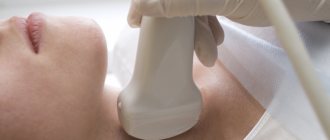Difference between ECG and Holter monitoring
A conventional electrocardiograph (ECG) records and evaluates the work of the heart in a short period of time. An ECG reveals only persistent changes in the myocardium, which are not affected by general health, physical activity, or emotional background (stress, anxiety). Even if the day before a person had an attack of pain or heart rhythm disturbances, the cardiograph may not show any pathological changes.
With Holter monitoring, the electrical activity of the heart is recorded for 1–3 days, which makes it possible to see changes in the functioning of the heart while the patient is active, as well as during periods of rest and sleep. The Holter study is more informative and detects the slightest deviations from the norm that occur spontaneously and irregularly.
The latest models of the device are equipped with additional devices for recording daily blood pressure.
Who needs research
Indications for this examination include a number of pathological conditions of the patient:
- pain, heaviness behind the sternum;
- the presence of diabetes mellitus in the patient;
- pain in the heart, which can appear spontaneously or be observed constantly, occur even in a calm state or after emotional/physical stress;
- increased incidence of fainting, sudden dizziness, shortness of breath after exercise or at rest;
- diseases of the thyroid gland of various etiologies;
- recent heart attack.
Also, a study using the Holter method is carried out to clarify the effectiveness of the therapy prescribed by the doctor.
Is preparation required?
To pass the examination, serious preparation is not needed. If the doctor considers it necessary, the patient may first undergo a regular electrocardiogram. In addition, men with significant chest hair removal are recommended. This is necessary because the Holter electrodes will be placed near the heart by the doctor, and failure to follow this recommendation may affect the quality of the study. There are no contraindications for examination using the Holter method.
List of indications for a Holter study:
- The absence of pathological changes on a traditional ECG when the patient complains of burning chest pain, shortness of breath, that is, symptoms indicating cardiac ischemia.
- Symptoms indicating arrhythmia: dizziness, fainting, rapid heartbeat, interruptions in heart function.
- Analysis of the effectiveness of treatment of coronary heart disease and arrhythmias.
- Monitoring the functions of the pacemaker.
- Dynamic monitoring of people at risk for arrhythmias and coronary heart disease.
- Arterial hypertension in combination with cardiovascular failure.
- Preparation for surgery in people with myocardial pathology.
Important! Holter monitoring to assess the condition of the heart muscle is recommended for persons who have undergone chemotherapy or radiotherapy for cancer.
How is monitoring carried out?
Recording an ECG using the Holter method is not difficult. Before starting the study, the cardiologist conducts an external examination of the patient. Then the sensors of a compact portable recorder are attached to his chest, after which they are fixed with an adhesive plaster. Nowadays, such a device is available in two types:
- three-channel models;
- twelve-channel models.
If the patient has had cases of allergic reactions, the doctor conducting the study should be warned about this, since sometimes an allergy to the patch with which the electrodes is attached is possible.
The fixing device itself is located on the patient’s belt. You need to wear it without taking it off throughout the day - this is the only way to get objective, accurate information about the state of the cardiovascular system. During monitoring, you should adhere to the following rules:
- do not take a shower or bath;
- do not get close to power lines;
- protect the device from overheating or mechanical damage;
- slightly limit physical activity so as not to cause excessive sweating;
- keep a diary of self-monitoring of blood pressure fluctuations.
In some cases, patients ask themselves: is it sometimes possible to fool the device? The doctors answer is unequivocal - no, this is impossible.
Kinds
The following types of Holter monitoring have been developed:
- Full-scale monitoring , in which the procedure lasts 1-3 days. The device transmits the received data to a specialist for the purpose of quickly deciphering the results.
- Fragmentary method , when recording is made only at moments when a person feels pain or feels symptoms of arrhythmia. If health deteriorates, the patient himself presses the start button of the device.
Our doctors
Kedrinskaya Larisa Ivanovna
Experience 18 years / Doctor of the highest category, Candidate of Medical Sciences / General practitioner, cardiologist
Sign up
Vershuta Elena Vasilievna
More than 23 years of experience / Highest category, Candidate of Medical Sciences / Pediatric cardiologist, cardiologist, therapist
Sign up
+
Preparation stages and features
The procedure does not require special preparation.
To obtain reliable research results, the patient must be informed about the features of the procedure and the rules that he needs to follow.
The recorder is a complex electronic device, therefore it is unacceptable for it to be exposed to the following factors: water, electric, magnetic fields, low and high temperatures, which may adversely affect its operation.
The patient must ensure the correct placement of the electrodes, and if they become detached from the skin, put them back in place.
It is mandatory to keep a diary, which records periods of a person’s physical and emotional activity, times of sleep, meals, medications, and indicates the nature and duration of complaints (chest pain, dizziness, shortness of breath).
The study has no contraindications, does not disrupt the patient’s usual lifestyle, and does not cause any unpleasant sensations or discomfort.
What patients say
According to reviews of people who completed this study, they did not experience any pain or discomfort while wearing the device.
The device leaves some inconveniences during sleep and active loads, but they are not significant. Important! It is worth getting a certificate from your doctor stating that you are undergoing a study using the Holter method - it is presented to law enforcement officers, it explains the purpose of the device and the essence of its work.
A complete comprehensive diagnosis of the functioning of blood vessels and the heart is the key to your health for many years.
Decoding the results
The received data is processed by a computer program - a decoder. After studying the results, the doctor gives a conclusion that includes information about the heart rate, the presence of extrasystoles and arrhythmias, changes in the blood supply to the myocardium, the reaction of the heart muscle to stress and other parameters. All identified pathologies are confirmed by ECG printouts for the monitoring period.
If you are worried about dizziness, aching pain in the heart, shortness of breath of unknown origin, contact a cardiologist at the Caring Doctor clinic, who will prescribe a heart study using Holter monitoring. This modern technique will allow the doctor to detect heart disease in the early stages, prescribe the correct treatment and prevent serious complications such as heart attacks and strokes.
Indications
Cases in which Holter ECG monitoring is necessary:
- The patient complains of loss of consciousness, dizziness, chest pain;
- Recent myocardial infarction accompanied by rhythm disturbances;
- Cardiomyopathy;
- Angina pectoris, ischemia;
- Monitoring treatment with antiarrhythmic drugs;
- Monitoring the operation of the pacemaker;
- There is an indicator - prolonged QT.
Analysis of heart rhythm variability, which represents the reaction of the human autonomic system, has an important function - predicting diseases of the cardiac system. The role of the doctor in such an examination can hardly be overestimated, despite the fact that electronics play the main role. Using the example of the Association of American Societies of Cardiology, one can judge how important the qualifications of a specialist are - a doctor receives the right to conduct independent diagnostics and interpret device data after seventy times of joint work with a specialist.
Ankle-brachial pressure index - ABI
The ankle-brachial index is a parameter that allows you to assess the adequacy of blood circulation in the lower extremities.
For this purpose, blood pressure is measured in the shoulder and ankle area. After this, these indicators are compared, as a result of which the doctor receives the ankle-brachial index. Typically, the pressure in the shoulder and ankle areas is the same. However, if the pressure in the ankle area is lower than in the shoulder area, this means that the arteries in the lower extremities may be narrowed. To determine the ankle-brachial index, the doctor uses a conventional blood pressure measuring device or an ultrasound machine. However, this parameter does not allow determining the location of arterial blockage. The ankle-brachial pressure index reflects the degree of stenosis or occlusion of the arteries of the lower extremities due to atherosclerotic obliteration. ABI <0.9 in both legs is considered positive for the diagnosis of peripheral atherosclerosis.
Holter testing - how long does the test take and what does it look like?
Many people wonder what a heart holter is and how the examination is carried out. First of all, you need to know that it lasts a relatively long time, because the device accompanies the patient for 24 or 48 hours, depending on the doctor's recommendations. Once the electrodes and machine are attached, the equipment should be worn throughout the test, during which your heart rate is recorded and monitored in a variety of situations and daily activities. The device is not removed during sleep, when the heart is also beating.
Thanks to this, the doctor has the opportunity to observe work in conditions in which it is impossible to use the traditional ECG method . During this time, the patient is required to keep a detailed diary in which he writes down any ailments and circumstances, indicating the time of their occurrence. If the patient is taking any medications, they should also indicate this in their records.
Currently, various devices for Holter testing are used. ECG signals in 2, 3 or 12 leads are recorded for 24 or 48 hours. In most cases, a three-channel system is used.
Pathologies revealed by the study
The study can be prescribed to patients of any age if indicated. Its difference from a regular ECG is that heart performance indicators are analyzed over a period of 24 hours or a longer period of time under conditions of normal life activities, and not in a supine position. This makes it possible to identify hidden disorders that may later cause life-threatening diseases.
The study makes it possible to diagnose coronary artery disease, confirm the need to install a pacemaker, and identify a high risk of developing a heart attack. The study is also prescribed if it is necessary to evaluate the effectiveness of treatment.
It is important to remember that the correct interpretation of the results obtained largely depends on the patient’s compliance with the doctor’s instructions, including filling out the activity diary. After receiving the conclusion, it is necessary to strictly follow all the doctor’s recommendations in order to prevent deterioration of health and the development of life-threatening conditions.
Complications
As such, no health complications were recorded after this study; rather, there are some inconveniences associated with wearing the device. Firstly, the recorder has weight and size, although small (from several tens of grams to 500), but it is difficult to sleep or perform any - active actions with him are not very comfortable. Secondly, a person entangled in wires is nowadays associated with a terrorist. As a result, misunderstandings may arise, even leading to serious police proceedings. Therefore, you must always have a medical certificate with you with a photograph of the device, which is issued by the medical center. institution simultaneously with the installation of the device.
Holter ECG results
ECG recordings are interpreted by a cardiologist or a functional diagnostics doctor. Usually the result is known the very next day after monitoring. Based on the Holter ECG conclusion, the preliminary diagnosis can be confirmed or refuted, or some other disease can be identified. The conclusion also indicates recommendations for the further management of this patient. Taking them into account, the attending physician develops a treatment regimen, calculates the dosage of medications and plans a rehabilitation program for the patient. Holter monitoring is much more informative than a conventional cardiogram. This procedure makes it possible to detect conditions that are potentially dangerous to human health and life at the earliest stages, which greatly facilitates their further treatment and makes it possible to avoid dire consequences.
What is the average cost of installing an ECG and blood pressure monitor in St. Petersburg
The price for installing a monitor depends on several parameters:
- The duration of rhythm registration is from 1 to 3 days;
- Which device is used: 7 channel or 12 channel;
- Classic HM or multifunctional with additional blood pressure measurement.
The average price for monofunctional classical Holter monitoring in St. Petersburg ranges from 2000 to 3500 rubles. In the “LIC” Clinics, HM with registration in 3 leads with 7 electrodes is 1900 rubles. XM with additional functions ECG + BP price 2500 rub. Monitoring 2 days 3800 rub.









